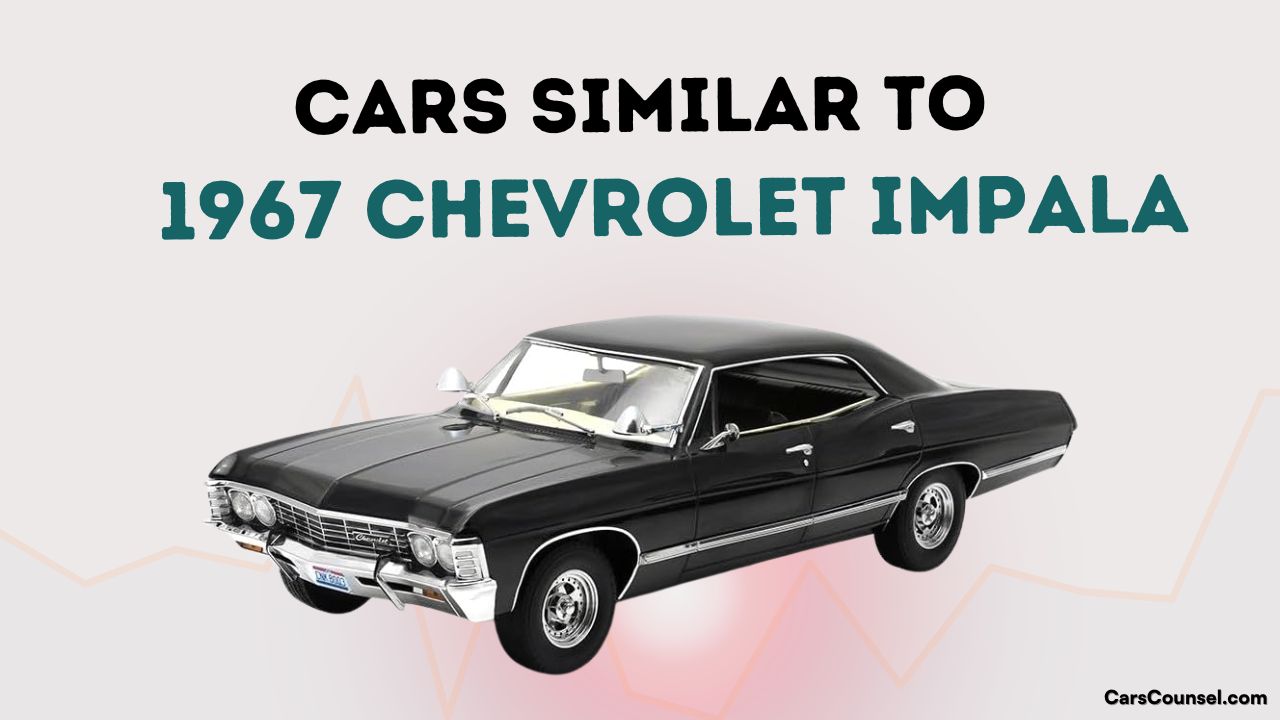If you’re exploring cars similar to the 1967 Chevrolet Impala, you’d naturally consider the Ford Galaxie 500 and Plymouth Sport Fury, both key rivals in the full-size segment back then.
Each offered spacious interiors and powerful engines but differed in driving dynamics: the Galaxie focused on a quiet, comfortable ride, while the Sport Fury emphasized handling and performance, though with some quality control issues.
The Impala balanced these traits with strong braking and competent handling, making the competition nuanced depending on what you value most. But these surface impressions only tell part of the story.

Quick Navigation
Key Takeaways
- The 1967 Ford Galaxie 500 and Plymouth Sport Fury were the main full-size cars comparable to the Chevrolet Impala 1967, sharing similar market segments and performance metrics.
- The Ford Galaxie 500 featured softened lines with geometric tail lights and focused on a smoother, quieter ride, priced slightly below the Impala.
- Plymouth Sport Fury offered conservative styling improvements, an extruded grille, flood-lit instrument panel, and a 325-horsepower engine matching the Impala SS.
- All three models—Impala SS, Galaxie 500, and Sport Fury—had closely matched handling and braking, with Chevrolet balancing performance and Plymouth facing some quality issues.
- Pricing for these cars was competitive, with the Impala SS at $3,661, Ford Galaxie 500 at $3,490, and Plymouth slightly lower, reflecting consumer preferences and optional features.
Full-Size Car Market Landscape in the Late 1960s
Although full-sized cars made up over half of the U.S. auto sales in 1967, the market was largely dominated by the “Low Priced Three”: Chevrolet, Ford, and Plymouth, which together accounted for 57% of full-sized segment volume.
Chevrolet led decisively with 1,201,700 units sold, mainly driven by the popularity of the Chevy Impala. Ford followed with 877,127, and Plymouth trailed at 317,310.
Plymouth’s market share rebounded to 13% by 1967 after conservative styling improvements.
Pricing for comparable models like the Impala SS was around $3,661, slightly above Ford’s Galaxie 500, reflecting design and feature distinctions in this competitive full-size market.
Styling and Design Characteristics of 1967 Full-Size Models
The 1967 Chevrolet Impala stood out with its curvier contours, pronounced hips, and a sloping roofline, presenting a more dynamic and modern silhouette compared to many of its full-size competitors.
Chevy took Bill Mitchell’s earlier clean design and evolved it into a bolder, more sculpted look.
Meanwhile, Ford’s 1967 Galaxie 500 softened its lines for a flowing style but kept geometric tail lights, reflecting an evolution without abandoning tradition.
Plymouth’s Sport Fury contrasted with more conservative styling, featuring an extruded grille and flood-lit instrument panel.
Interiors across these models improved safety and usability, with Chevy offering full instrumentation for a refined driver experience.
Performance Comparisons: Chevrolet Impala vs. Ford Galaxie and Plymouth Sport Fury
When comparing the 1967 Chevrolet Impala SS, Ford Galaxie 500, and Plymouth Sport Fury, you’ll find that all three offer similar engine power, with the Impala SS and Sport Fury producing 325 horsepower and the Galaxie 500 slightly less at 315 horsepower.
Handling and braking performance are closely matched, though the Plymouth’s brakes suffer from previous hard use. Ford emphasizes a smoother, quieter ride over sharp responsiveness, and Chevrolet strikes a balance between the two.
Despite their comparable performance, quality control issues were a notable drawback for both Chevrolet and Plymouth, with Ford generally having the edge in overall reliability during this era.
Acceleration and Braking
Acceleration and braking characteristics among the 1967 Chevrolet Impala SS, Ford Galaxie 500, and Plymouth Sport Fury show distinct priorities despite similar overall power outputs.
The Impala SS, with its 396 4V V8 producing 325 horsepower, delivers competent acceleration and the best braking performance of the trio, making it a balanced performer.
The Ford Galaxie 500’s 390 4V V8 offers 315 horsepower but emphasizes quietness and ride comfort over sharp responsiveness.
The Plymouth Sport Fury, while praised for superior handling, suffered from criticized braking, especially in test vehicles that had seen hard use.
Both Plymouth and Chevrolet had quality control concerns affecting reliability.
Engine Power and Handling
Three notable full-size American cars from 1967, the Chevrolet Impala SS, Ford Galaxie 500, and Plymouth Sport Fury, offered closely matched engine power yet distinct driving character.
The Impala delivered 325 hp from a 396 cubic inch V8, balancing fuel economy and handling. The Galaxie’s 390 V8 produced 315 hp, focusing on ride comfort and isolation. The Sport Fury’s Mopar 383 also made 325 hp, praised for performance but with weaker brakes due to prior test wear.
- Impala SS: Competent braking, balanced handling
- Galaxie 500: Softer ride, less responsive
- Sport Fury: Strong power but criticized braking
All showed similar performance, highlighting 1967’s full-size car competitiveness centered on engine power and handling nuances.
Pricing and Optional Features in 1967 Full-Size Chevrolet Competitors
Although priced slightly higher at $3,661 compared to the Ford Galaxie 500’s $3,490, the 1967 Chevrolet Impala SS offered a competitive balance of features and performance, reflecting its position among full size American sedans of the era. Optional features like air conditioning were likewise priced between Chevrolet and Ford at $356, with Plymouth offering it slightly cheaper at $338. Consumers could customize configurations, such as the Galaxie 500 mixing upgraded engines with basic hubcaps. Brand loyalty played a big role, with buyers often sticking to Chevrolet, Ford, or Plymouth based on tradition.
| Model | Base Price (1967) | Air Conditioning Cost | Notable Features |
|---|---|---|---|
| Chevrolet Impala SS | $3,661 | $356 | Balanced features, SS trim |
| Ford Galaxie 500 | $3,490 | $356 | Engine upgrades optional |
| Plymouth Sport Fury | Competitive | $338 | Lower air conditioning cost |
This pricing and features strategy highlighted the careful balance full size sedans struck between consumer preferences and functionality in 1967.
Brand Loyalty and Consumer Preferences Among Full-Size Cars
Brand loyalty played a major role in the full-size car segment of the 1960s, with many buyers sticking to familiar brands like Chevrolet, Ford, and Plymouth across generations.
Chevrolet’s dominance in 1967, selling over 1.2 million full-sized cars, reflected strong consumer preference shaped by consistent styling and perceived value.
Meanwhile, Plymouth’s market share struggled due to styling and quality issues but recovered somewhat by adopting more conservative designs that aligned better with consumer priorities for function over flashiness.
Brand Loyalty Trends
Loyalty to full-sized car brands in the 1960s often stemmed from personal and familial ties, with many consumers sticking to the same manufacturer across generations.
Chevy and Ford dominated this market, with Chevrolet leading sales, especially for full-sized cars like the Impala.
Brand loyalty was driven by:
- Reliable performance and functionality prioritized over style, keeping customers devoted.
- Plymouth’s conservative styling helped regain market share, though it trailed Ford and Chevrolet.
- Family influence reinforced long-term allegiance to brands like Ford, shaping purchase decisions.
Understanding these trends helps explain why Chevy and Ford maintained strong footholds during this era.
Consumer Priorities
Strong consumer preferences in the full-size car market during the 1960s hinged on a balance of style, functionality, and value. Chevrolet capitalized on this with the 1967 Impala, leading sales due to its stylish design and comprehensive instrumentation.
Buyers prioritized usability and performance features over mere aesthetics, favoring cars that delivered reliable functionality. The “Low Priced Three”—Chevrolet, Ford, and Plymouth—dominated, representing 57% of segment volume, reflecting consumers’ preference for affordability.
Plymouth’s market share rise to 13% in 1967 showed conservative styling still mattered, highlighting how design choices shaped consumer priorities distinctly within the full-size segment.
Market Share Dynamics
While you might expect consumers in the full-size car market to frequently switch brands, the reality in 1967 was quite the opposite: buyers showed remarkable consistency in their brand choices, reinforcing Chevrolet’s dominance with over 1.2 million Impalas sold that year.
Brand loyalty shaped the market, particularly among buyers of the Chevrolet Bel Air and Impala models. Key market share dynamics include:
- Chevrolet led with 1,201,700 full-size cars sold, far surpassing Ford and Plymouth.
- Plymouth regained a 13% market share due to conservative styling appealing to function-focused buyers.
- Generational brand loyalty was strong, with consumers like “Granddaddy Will” exclusively choosing Ford, making switching rare.
This loyalty stabilized brand shares and influenced sales patterns in the 1960s full-size car segment.
Ford Competitors to the 1967 Chevrolet Impala
Ford positioned the 1967 Galaxie 500 as a key competitor to the Chevrolet Impala by emphasizing spaciousness and ride comfort while offering strong performance options.
You get a roomy interior and a quiet driving experience with the Galaxie, which featured a 390 4V V8 engine producing 315 horsepower.
While sportiness took a backseat, Ford’s design shifted to flowing lines that boosted its appeal among full-size cars.
Pricing was slightly lower than the Impala, attracting buyers loyal to Ford’s brand.
General Motors’ Full-Size Car Rivals to the Impala
General Motors offered several full-size car models that directly competed with the 1967 Chevrolet Impala by sharing the same platform and targeting a broad consumer base.
You could consider these rivals:
- Oldsmobile 88: A sibling to the Impala, offering similar full-size features and comparable performance options.
- Pontiac Catalina: Known for its spacious interior and performance, matching the Impala’s appeal to consumers.
- Buick LeSabre: Positioned as a more luxurious alternative, providing comfort alongside performance.
GM’s strategy with these models competed internally while also fending off Chrysler products in the full-size segment.
Chrysler and Plymouth as Competitors in the Full-Size Segment
Chrysler and Plymouth also made a strong play in the full-size car market in 1967, directly challenging Chevrolet’s Impala with models like the Plymouth Sport Fury.
Alongside the Sport Fury, several other models such as the Plymouth Fury and Belvedere sought to attract buyers through distinctive styling and performance options.
Both brands matched the Impala in price, with the Sport Fury Fast Top and Impala SS each costing $3,661.
Plymouth was noted for superior handling, contrasting Chevrolet’s emphasis on ride comfort.
Despite quality control issues, Plymouth maintained appeal with features like an extruded grille and flood-lit instrument panel.
Conclusion
The 1967 Chevrolet Impala stood as a balanced contender among full-size cars, blending handling sharpness and ride comfort better than its peers. The Ford Galaxie 500 leaned toward a cushioned, smooth cruise, while the Plymouth Sport Fury emphasized performance but struggled with reliability issues. All offered spaciousness and power, yet each carved its own niche—like different instruments in a Detroit symphony—reflecting varied priorities but sharing the spotlight in the late 1960s full-size car arena.

